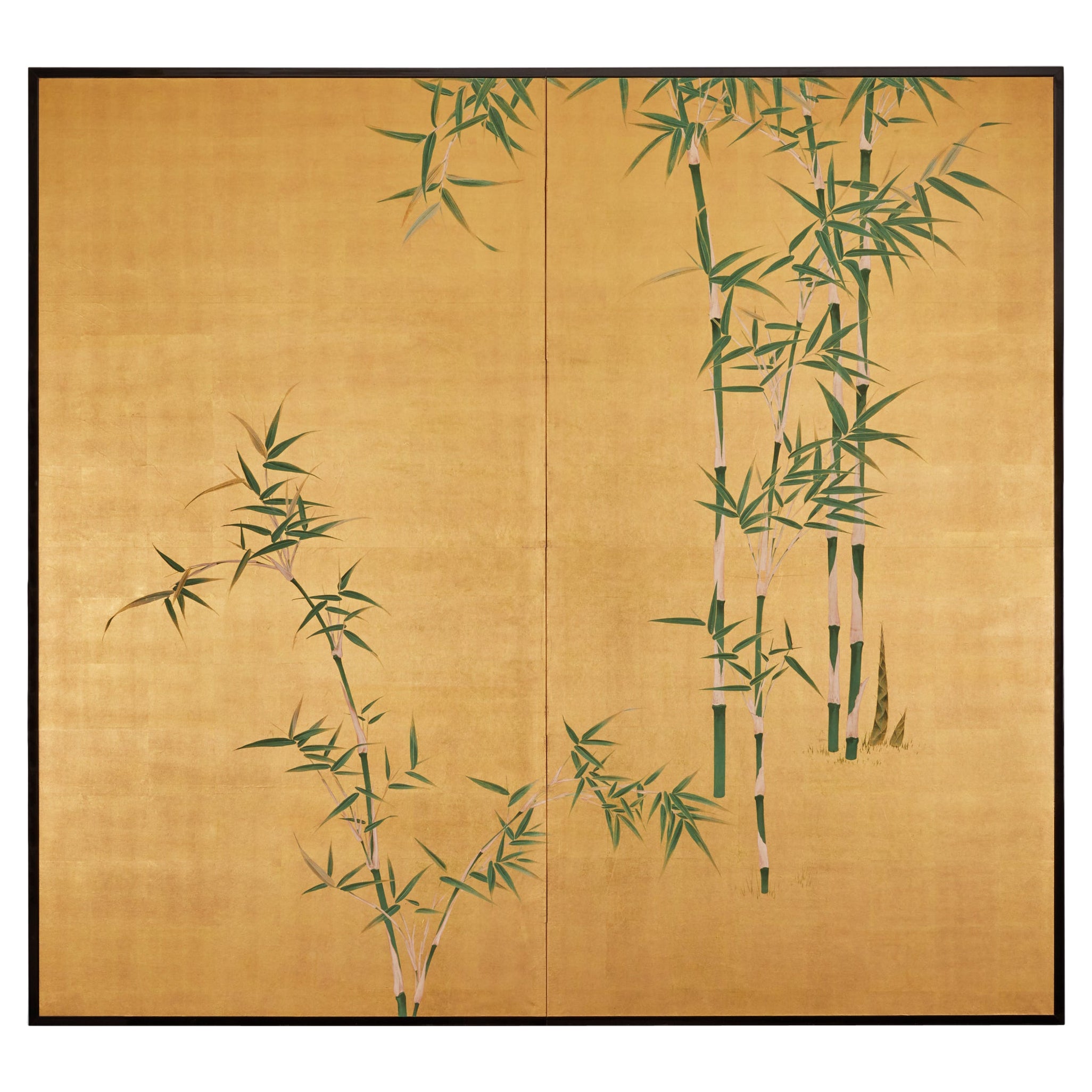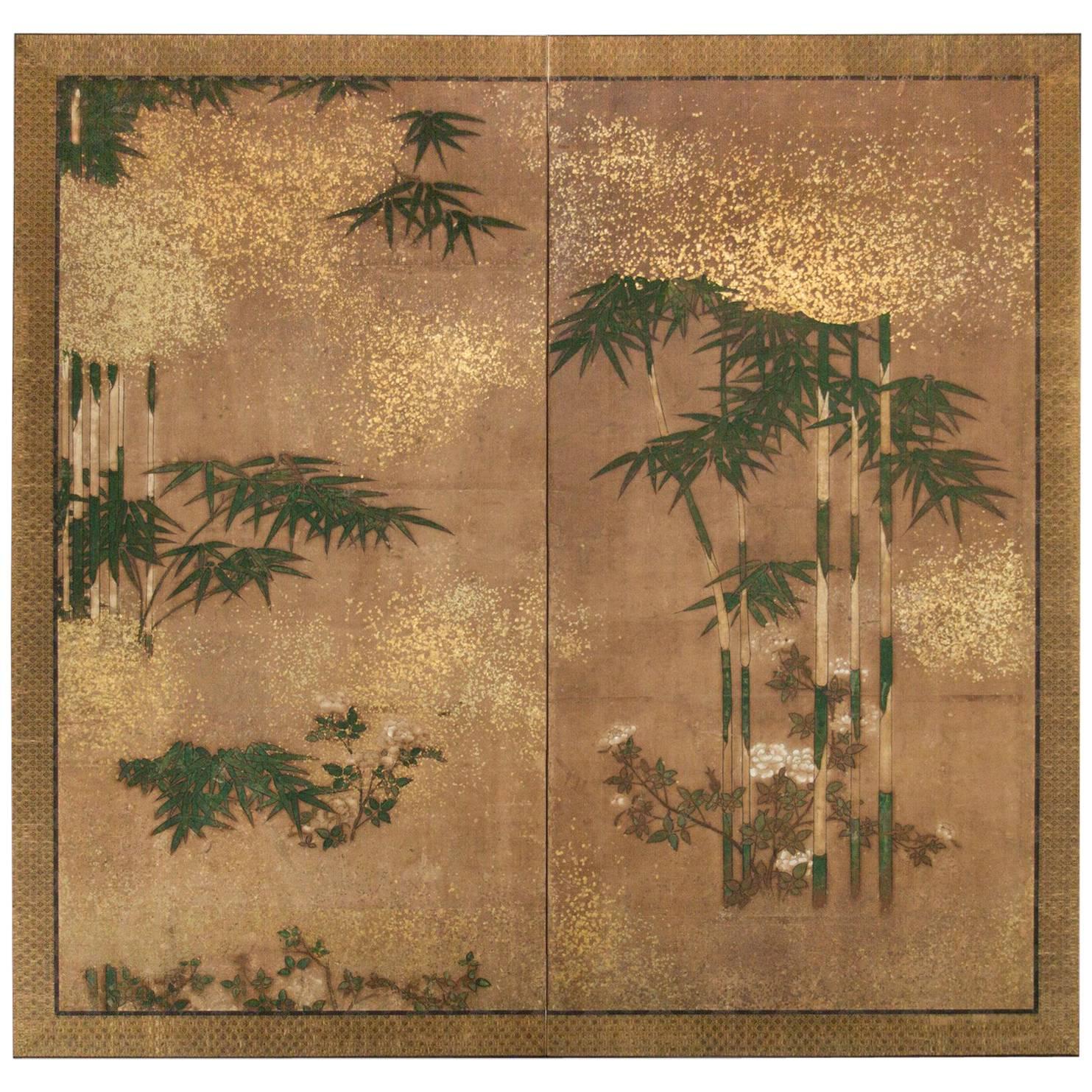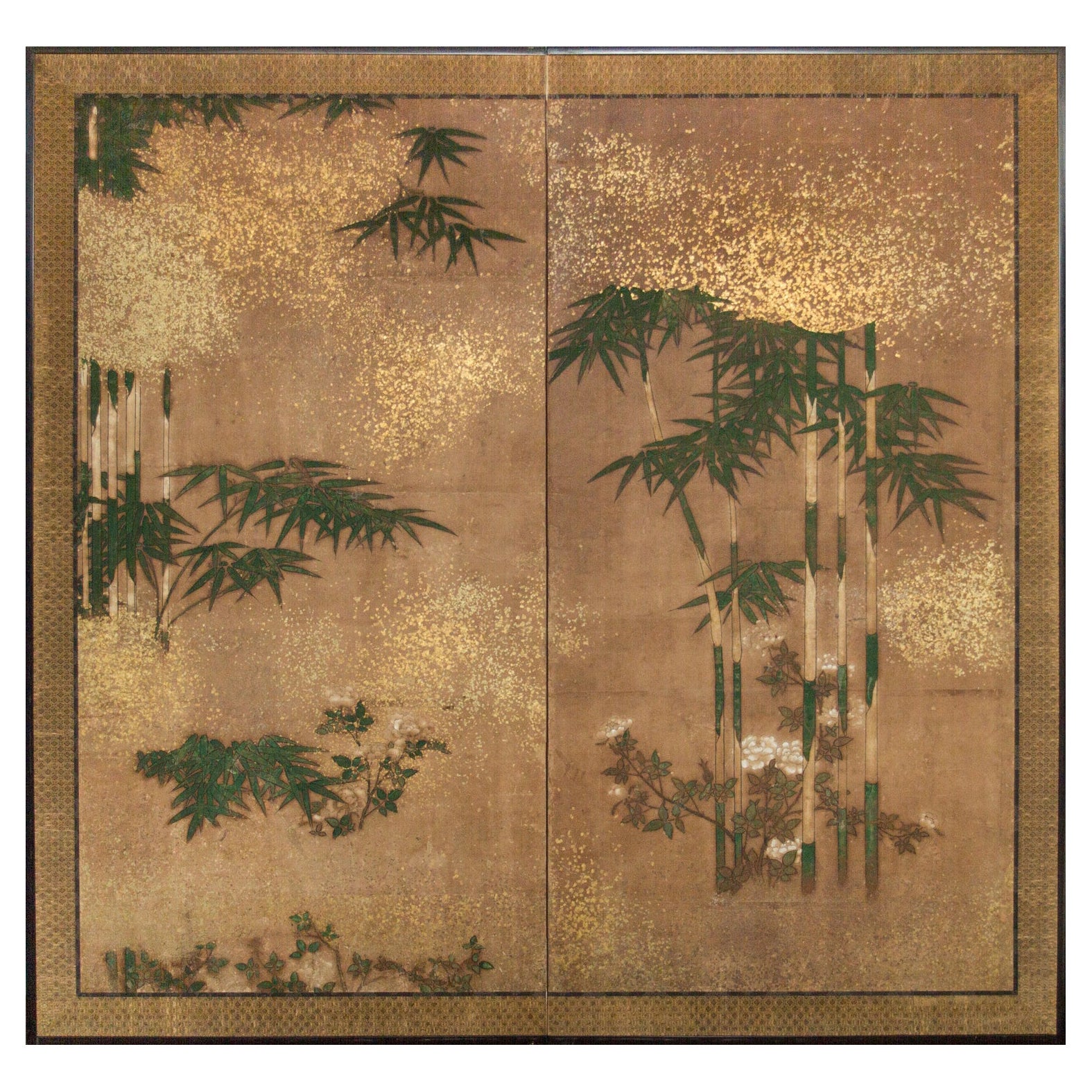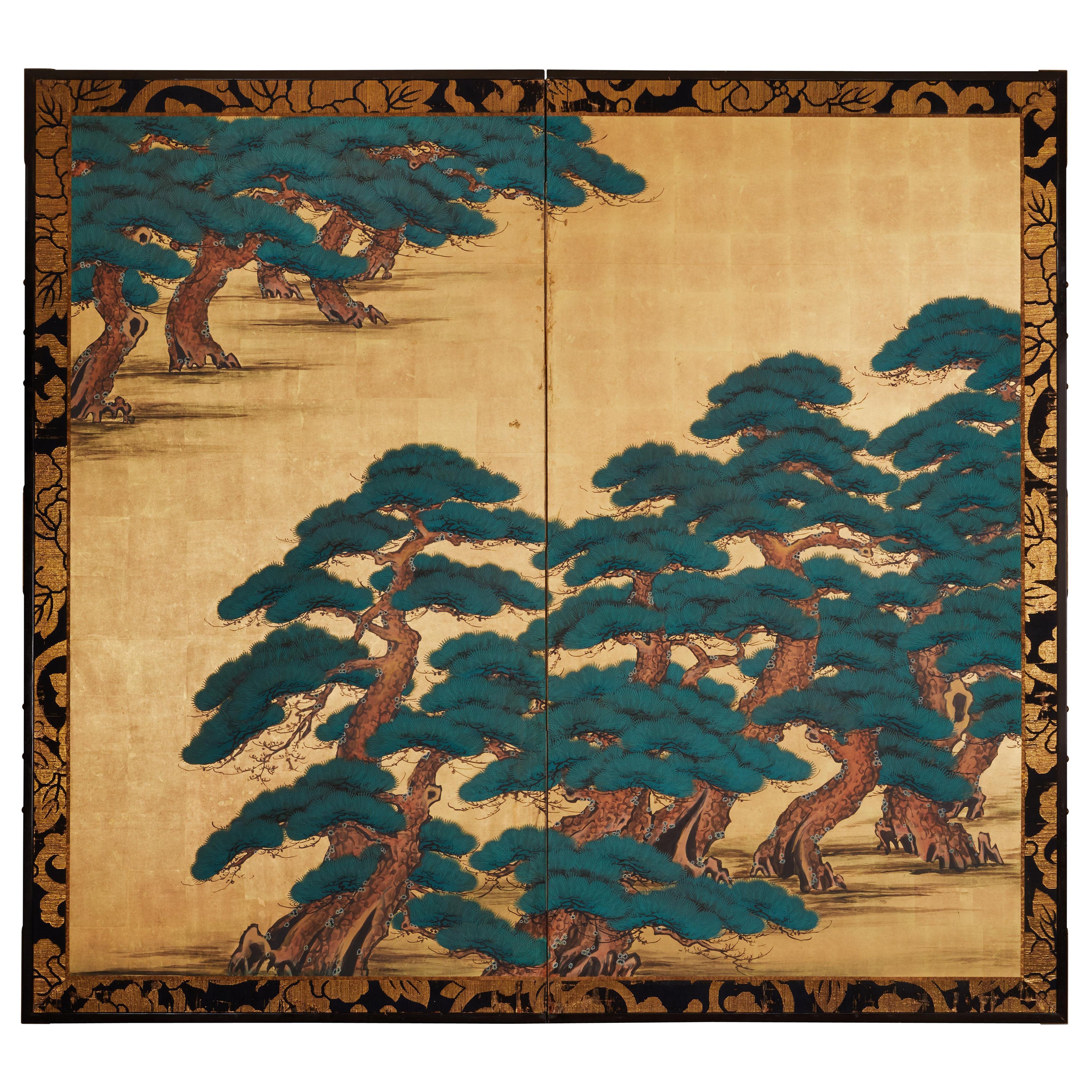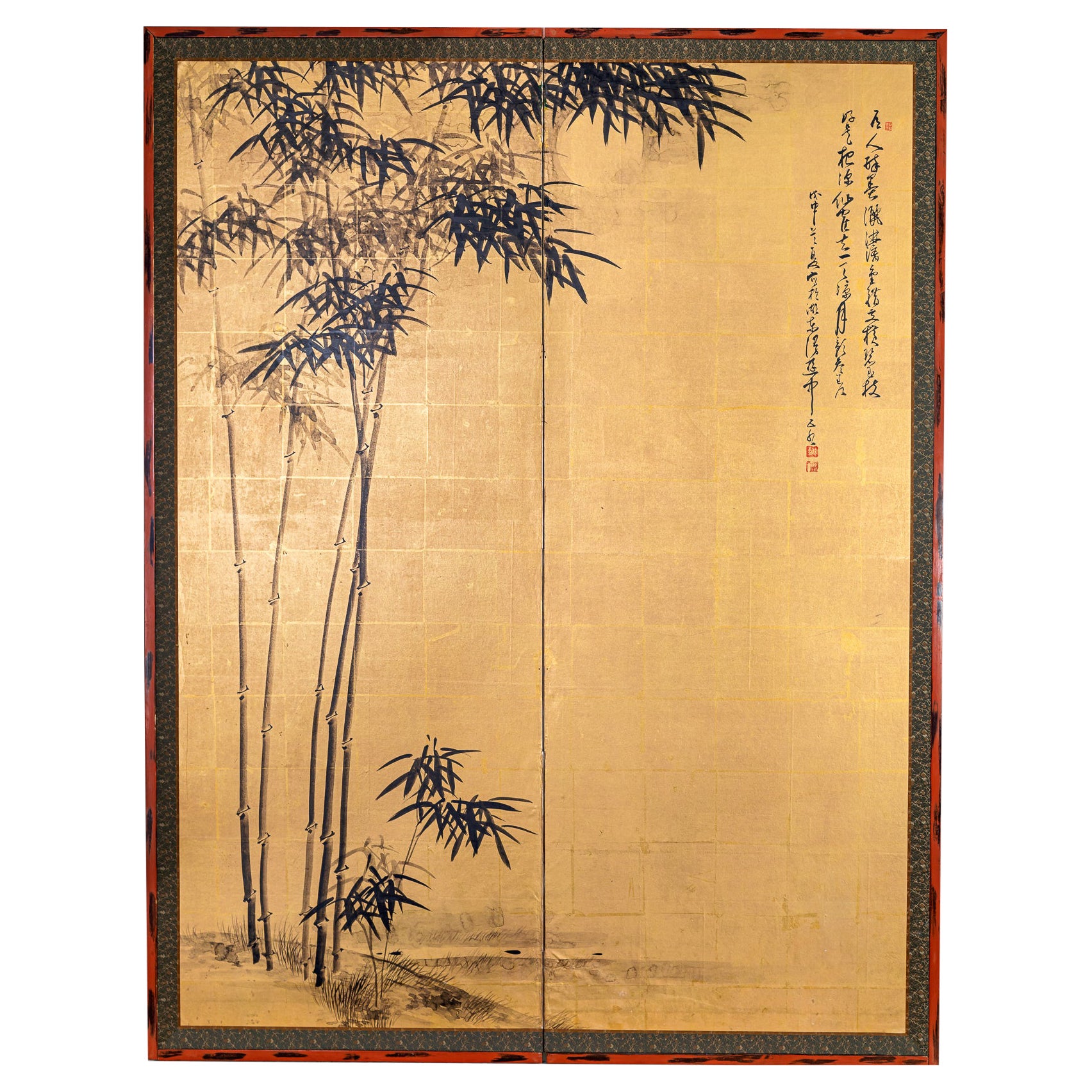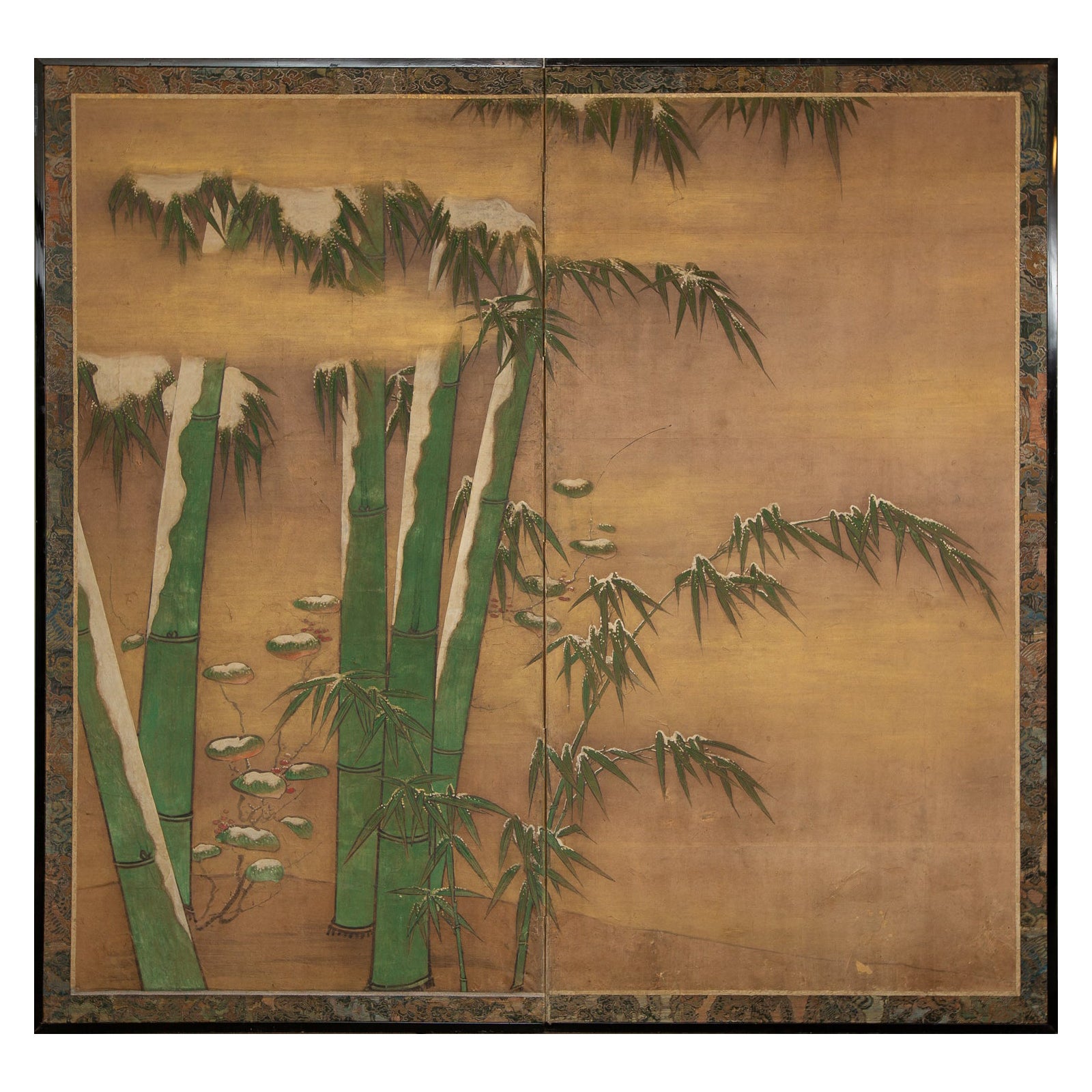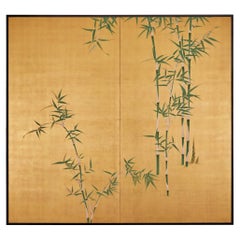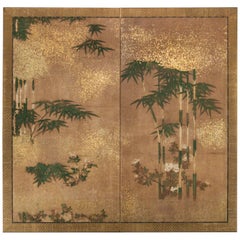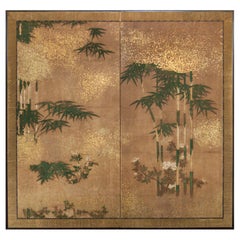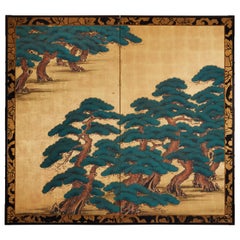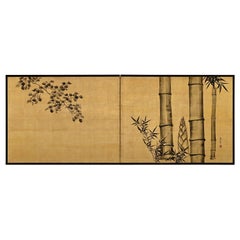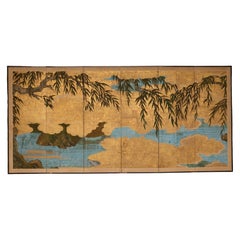Items Similar to Japanese Two Panel Screen: Bamboo on Gold
Want more images or videos?
Request additional images or videos from the seller
1 of 10
Japanese Two Panel Screen: Bamboo on Gold
$40,250
£30,284.38
€34,979.11
CA$56,883.76
A$61,727.55
CHF 32,710.16
MX$757,058.31
NOK 404,785.88
SEK 382,501.22
DKK 261,136.49
About the Item
Bamboo grove on a knoll with stylized gold mist. Mineral pigments on gold leaf with silk brocade border.
- Dimensions:Height: 69.5 in (176.53 cm)Width: 76.5 in (194.31 cm)Depth: 0.75 in (1.91 cm)
- Materials and Techniques:
- Place of Origin:
- Period:
- Date of Manufacture:c.1820
- Condition:Condition report upon request.
- Seller Location:Hudson, NY
- Reference Number:Seller: S03861stDibs: LU855134325872
About the Seller
5.0
Recognized Seller
These prestigious sellers are industry leaders and represent the highest echelon for item quality and design.
Established in 1971
1stDibs seller since 2008
166 sales on 1stDibs
Typical response time: 6 hours
Associations
The Art and Antique Dealers League of AmericaAntiques Associations Members
- ShippingRetrieving quote...Shipping from: Hudson, NY
- Return Policy
Authenticity Guarantee
In the unlikely event there’s an issue with an item’s authenticity, contact us within 1 year for a full refund. DetailsMoney-Back Guarantee
If your item is not as described, is damaged in transit, or does not arrive, contact us within 7 days for a full refund. Details24-Hour Cancellation
You have a 24-hour grace period in which to reconsider your purchase, with no questions asked.Vetted Professional Sellers
Our world-class sellers must adhere to strict standards for service and quality, maintaining the integrity of our listings.Price-Match Guarantee
If you find that a seller listed the same item for a lower price elsewhere, we’ll match it.Trusted Global Delivery
Our best-in-class carrier network provides specialized shipping options worldwide, including custom delivery.More From This Seller
View AllJapanese Two Panel Screen: Young Bamboo on Gold
Located in Hudson, NY
Symbolizing the Sun, gold is often used in shrines and temples in Japan. Gold has been extensively recognized to represent wealth, while bamboo is said to bring good luck due to its ability to regenerate in the forest. A beautiful composition of the two together...
Category
Antique Late 19th Century Japanese Paintings and Screens
Materials
Gold
Japanese Two Panel Screen: Bamboo Grove on Mulberry Paper with Gold Dust
Located in Hudson, NY
Kano School painting of a bamboo grove with blooming flowers and gold dust mists. Painted in mineral pigments on mulberry paper with gold dust and a silk brocade border.
Category
Antique Early 19th Century Japanese Edo Paintings and Screens
Materials
Gold
Japanese Two Panel Screen: Bamboo Grove on Mulberry Paper with Gold Dust
Located in Hudson, NY
Kano School painting of a bamboo grove with blooming flowers and gold dust mists. Painted in mineral pigments on mulberry paper with gold dust and a silk brocade border.
Category
Antique Early 19th Century Japanese Paintings and Screens
Materials
Gold
Japanese Two Panel Screen: Pine on Heavy Gold
Located in Hudson, NY
Kano School painting in mineral pigments on mulberry paper with heavy gold leaf and a silk brocade border made of antique monk's robes.
Category
Antique Late 19th Century Japanese Paintings and Screens
Materials
Gold Leaf
Japanese Two Panel Screen: Bamboo with Calligraphy Poem
Located in Hudson, NY
Moon and bamboo in ink on gold paper with red and black lacquered negoro frame. (Meiji period) Calligraphy reads: Beauty in ink painting with standing woods and branches, like in par...
Category
Antique Early 1900s Japanese Paintings and Screens
Materials
Paper
Japanese Two Panel Screen Bamboo in Early Snow
Located in Hudson, NY
Kano School painting, of the edge of a bamboo grove in early winter snow with very fine gold mist. Mineral pigments and gold dust on mulberry paper with 18th century brocade.
Category
Antique 18th Century Japanese Paintings and Screens
Materials
Paper
You May Also Like
19th Century Japanese Screen for Tea-Ceremony, Ink Bamboo and Plum on Gold Leaf
Located in Kyoto, JP
Three Friends of Winter
Nakajima Raisho (1796-1871)
Late Edo period, circa 1850
Ink and gold leaf on paper.
This is a double-sided Japanese Furosaki or tea-ceremony screen from the mid 19th century; bamboo and plum on the front, young pines the back. It by Nakajima Raisho, a master painter of the Maruyama school in the late Edo and early Meiji periods. In this work Raisho combines exquisite ink brushwork with large open spaces of brilliant gold-leaf to inspire the viewers imagination. Rather than naturalism, he is searching for the phycological impression of the motifs, resulting in abstraction and stylization. His simplification of the motifs the result of looking to capture the inner nature of the objects. This art motif is known as Sho Chiku Bai, or the Three Friends of Winter. Evergreen pine connotes steadfastness, bamboo suggests both strength and flexibility, while plum blossoms unfurling on snow-laden branches imply hardiness. Combined, this trio is emblematic of Japanese new year. Chinese literati were the first to group the three plants together due to their noble characteristics. Like these resilient plants flowering so beautifully in winter, it was expected of the scholar-gentleman to cultivate a strong character with which he would be able to show the same degree of perseverance and steadfastness even during times of adverse conditions.
The screen would have been placed near the hearth of a room used for the Japanese tea ceremony, shielding the fire from draughts and also forming a stimulating and decorative backdrop behind the tea utensils. It would have been used in the Hatsugama, or first tea-ceremony of the new year.
Nakajima Raisho (1796-1871) originally studied under Watanabe Nangaku before entering the school of Maruyama Ozui. He was the highest ranking Maruyama school painter at the end of the Edo period and was known as one of the ‘Four Heian Families’ along with Kishi...
Category
Antique Mid-19th Century Japanese Edo Paintings and Screens
Materials
Gold Leaf
Antique 19th Century Japanese Two-Panel Screen ‘Byobu’, Kano School, Edo Period
Located in London, GB
Japanese Kano School Edo period two-panel screen depicting flowering prunus and bamboo on a rock formation, with colorful birds next to a body of water. ...
Category
Antique Mid-19th Century Japanese Edo Paintings and Screens
Materials
Gold Leaf
Japanese antique screen - EDO period - Willow over a stream
Located in Prahran, Victoria
Antique Japanese 6 panel screen from the early Edo period (C1650). One of a pair (both available). This magnificent golden screen shows...
Category
Antique 1650s Japanese Edo Paintings and Screens
Materials
Gold Leaf
Pair of Japanese Edo Six Panel Screens the Seven Sages
Located in Rio Vista, CA
Fantastic pair of 19th century Japanese late Edo/early Meiji period six-panel screens titled The seven sages of the bamboo grove. The Kano school screens...
Category
Antique 19th Century Japanese Edo Paintings and Screens
Materials
Brass, Gold Leaf
JapaneseAntiques Terasaki kogyo, Gold background, Bamboo and plum folding screen
Located in Niiza, JP
material: paper and cloth
Unfolded size: 1600 x 1660 mm
Can be folded in half: 800 x 1660 mm, 6 kg
Estimated packing size: (Sandwich with 12mm plywood)
10 × 95 × 185cm 30kg
A bold ...
Category
20th Century Paintings and Screens
Materials
Paper
Japanese Bamboo & Orchids 4-Panel Byobu Screen
Located in Astoria, NY
Japanese Bamboo and Orchids Scene Four-Panel Byobu Screen, gouache on silk, with iron red six character mark on the lower right panel, in ebonized wood frame. 24" H x 39" W. Provenan...
Category
20th Century Japanese Ming Paintings and Screens
Materials
Silk, Hardwood
More Ways To Browse
Bamboo Gold
Gold Bamboo Furniture
Japanese Silk Brocade
Japanese Painting Silk Gold
Mineral Pigments On Silk
Japanese Screen Bamboo
Japanese Lacquer Panels
Chinese Carved Screen
Kano School
Byobu Screens
Asian Black Screens
Japanese Folding Screen Screen
Japanese Silk Brocade
Asian Cranes
Chinese Silk Paintings
Mid Century Chinese Screen
The Imperial Palace Of China
Asian Art On Paper
